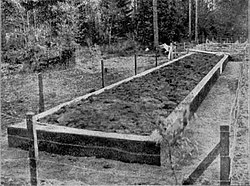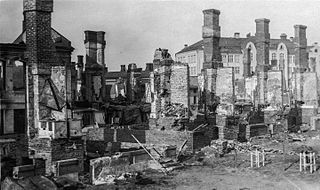
The Finnish Civil War was a civil war in Finland in 1918 fought for the leadership and control of the country between White Finland and the Finnish Socialist Workers' Republic during the country's transition from a grand duchy ruled by the Russian Empire to a fully independent state. The clashes took place in the context of the national, political, and social turmoil caused by World War I in Europe. The war was fought between the Red Guards, led by a section of the Social Democratic Party, and the White Guards, conducted by the senate and those who opposed socialism with assistance late in the war by the German Imperial Army at the request of the Finnish civil government. The paramilitary Red Guards, which were composed of industrial and agrarian workers, controlled the cities and industrial centres of southern Finland. The paramilitary White Guards, which consisted of land owners and those in the middle and upper classes, controlled rural central and northern Finland, and were led by General C. G. E. Mannerheim.

The White Guard, officially known as the Civil Guard, was a voluntary militia, part of the Finnish Whites movement, that emerged victorious over the socialist Red Guards in the Finnish Civil War of 1918. They were generally known as the "White Guard" in the West due to their opposition to the "communist" Red Guards. In the White Army of Finland many participants were recruits, draftees and German-trained Jägers – rather than part of the paramilitary. The central organization was named the White Guard Organization, and the organization consisted of local chapters in municipalities.

The Red Terror was a campaign of political repression and executions in Soviet Russia carried out by the Bolsheviks, chiefly through the Cheka, the Bolshevik secret police. It officially started in early September 1918 and lasted until 1922. Arising after assassination attempts on Vladimir Lenin along with the successful assassinations of Petrograd Cheka leader Moisei Uritsky and party editor V. Volodarsky in alleged retaliation for Bolshevik mass repressions, the Red Terror was modeled on the Reign of Terror of the French Revolution, and sought to eliminate political dissent, opposition, and any other threat to Bolshevik power.

In the military of ancient Rome, decimation was a form of military discipline in which every tenth man in a group was executed by members of his cohort. The discipline was used by senior commanders in the Roman army to punish units or large groups guilty of capital offences, such as cowardice, mutiny, desertion, and insubordination, and for pacification of rebellious legions. The procedure was an attempt to balance the need to punish serious offences with the realities of managing a large group of offenders.
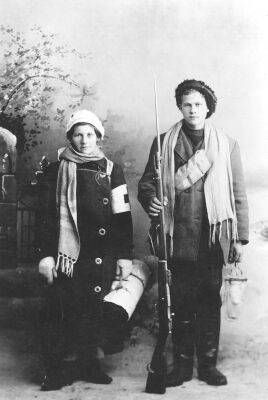
The Red Guards were the paramilitary units of the labour movement in Finland during the early 1900s. The Red Guards formed the army of Red Finland and were one of the main belligerents of the Finnish Civil War in 1918.

The Battle of Tampere was a 1918 Finnish Civil War battle, fought in Tampere, Finland from 15 March to 6 April between the Whites and the Reds. It is the most famous and the heaviest of all the Finnish Civil War battles. Today it is particularly remembered for its bloody aftermath as the Whites executed hundreds of capitulated Reds and took 11,000 prisoners who ended up in the Kalevankangas camp.

Capital punishment in Finland has been abolished de jure.

The following events occurred in February 1918:

Finnish Civil War prison camps were operated by the White Finns to hold prisoners of war during and after the Finnish Civil War in 1918.
The “Shoot on the Spot” Declaration was a statement issued by Carl Gustaf Emil Mannerheim, military leader of the Whites, on 25 February 1918, in the early stages of the Finnish Civil War. The Declaration was adopted as a rule of engagement of the White troops. Among other things, it directed the troops about the treatment of prisoners, and gave commanders of units wide powers to carry out executions at their sole discretion.

The Viipuri massacre was the killing of approximately 360 to 420 Russians in the city of Viipuri during the Finnish Civil War in April–May 1918. The massacre took place during and after the Battle of Viipuri as the White Guards captured the city from the Red Guards. At least half of the victims were Russian soldiers and military personnel. The slain were mainly men and young boys: nine out of ten were men fit for military service. The White Guards were "cleansing" the city of Red Guards, however, only a small minority of the killed Russians were affiliated with the Finnish labour movement.
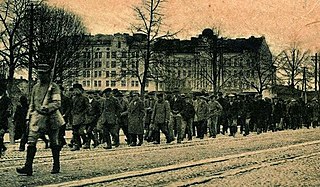
The Battle of Viipuri was a 1918 Finnish Civil War battle, fought 24–29 April between the Finnish Whites and the Finnish Reds in Viipuri. Together with the Battle of Tampere and Battle of Helsinki, it was one of the three major urban battles of the Finnish Civil War. The battle is also remembered because of its bloody aftermath, as the Whites executed up to 400 non-aligned military personnel and civilians of Russian and associated ethnicities.
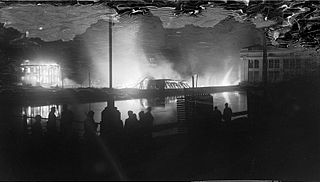
Battle of Varkaus was a battle of the 1918 Finnish Civil War, fought 19–21 February between the Finnish Whites and the Finnish Reds in Varkaus, Leppävirta. The victory was important for the Whites, giving them control of all of Northern Finland. The battle is best known for the bloody Lottery of Huruslahti held afterwards, where the Whites executed up to 180 Reds who had surrendered.
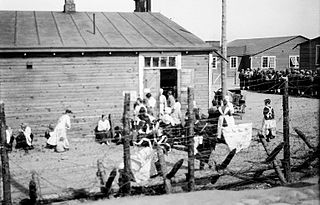
Tampere camp was a concentration camp operating from 6 April 1918 to 15 September 1918 in the Kaleva district of Tampere, Finland. It was set up for the Reds captured by the White Army after the Finnish Civil War Battle of Tampere.

Battle of Lahti was a 1918 Finnish Civil War battle, fought from 19 April to 1 May by the German troops and Finnish Whites against the Finnish Reds in Lahti, Finland. Together with the Battle of Viipuri, from 24 to 29 April, it was the last major battle of the war.

All-female units of the paramilitary Red Guards served in the 1918 Finnish Civil War. The first Women's Guards units formed in early February in the main Finnish cities. More than 15 female Guards units were established by the end of March 1918, with a total of about 2,000 women serving. The female Guards units consisted of young industrial workers, maids, and servants. Their average age was about 20, but some were as young as 14. The women served in auxiliary units in combat.

The Battle of Länkipohja was a Finnish Civil War battle fought in the village of Länkipohja on 16 March 1918 between the Finnish Whites and the Finnish Reds. Together with the battles fought in Kuru, Ruovesi and Vilppula between 15 and 18 March, the Battle of Länkipohja was one of the first military operations related to the Battle of Tampere, which was the decisive battle of the Finnish Civil War. The battle is known for its bloody aftermath as the Whites executed 70–100 capitulated Reds. One of the executions was photographed and the images have become one of the best known pictures of the Finnish Civil War.
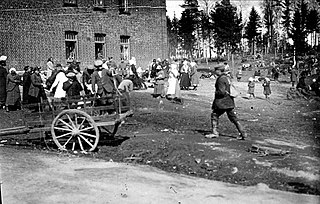
Hennala camp was a concentration camp operating from the beginning of May 1918 to 15 September 1918 in the Hennala Garrison in Lahti, Finland. It was set up for the Reds captured by the White Army after the Finnish Civil War Battle of Lahti.
The Haaga executions of 1918 took place in Etelä-Haaga in what was then the Rural Municipality of Helsinge during the Battle of Helsinki of the Finnish Civil War on 12 April 1918. A total of 45 persons suspected of belonging to the Red Guards were executed by German troops at a bog at 8 o’clock p.m. at the site of the present Eliel Saarisen tie, halfway from the Pitäjänmäki roundabout to the tunnel leading to the Huopalahti Station, at the site of a pedestrian crossing. 28 of those executed were buried in the Pohjois-Haaga mass grave, which is located close to the current Pohjois-Haaga railway station.
The Harmoinen sick room mass murder was a significant incident in the Harmoinen village of the Kuhmoinen Parish that took place on 10 March 1918, during the Finnish Civil War, which according to the Reds met the criteria for a massacre. It took place during the Battle of Kuhmoinen, when the Whites executed 11 Red Guard patients and two male sanitaries. The Whites belonged to the 1st company and its battalion commanded by the Estonian born Hans Kalm. Kalm was not part of the incident and did not know anything about it, as he was engaged in the defense of the Kuhmoinen parish center at the time, against the Red Guards offensive in the direction of Jämsä. These claims are based on the stories by two survivors, reports by the Whites and other materials. Researcher of political history Jaakko Paavolainen thinks that "it is possible that shots were fired from the sick room, as the Whites have reported, but the claim that the snipers would have retired to the beds inside, is a rather fantastic one."
